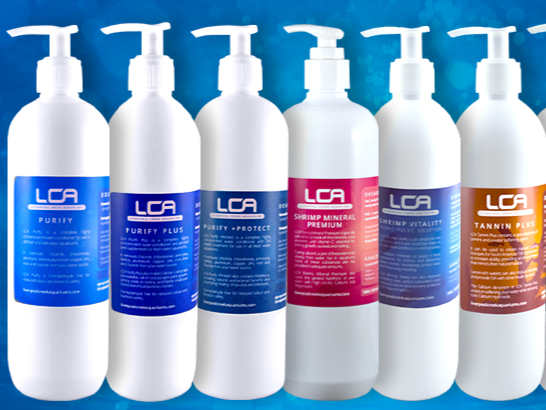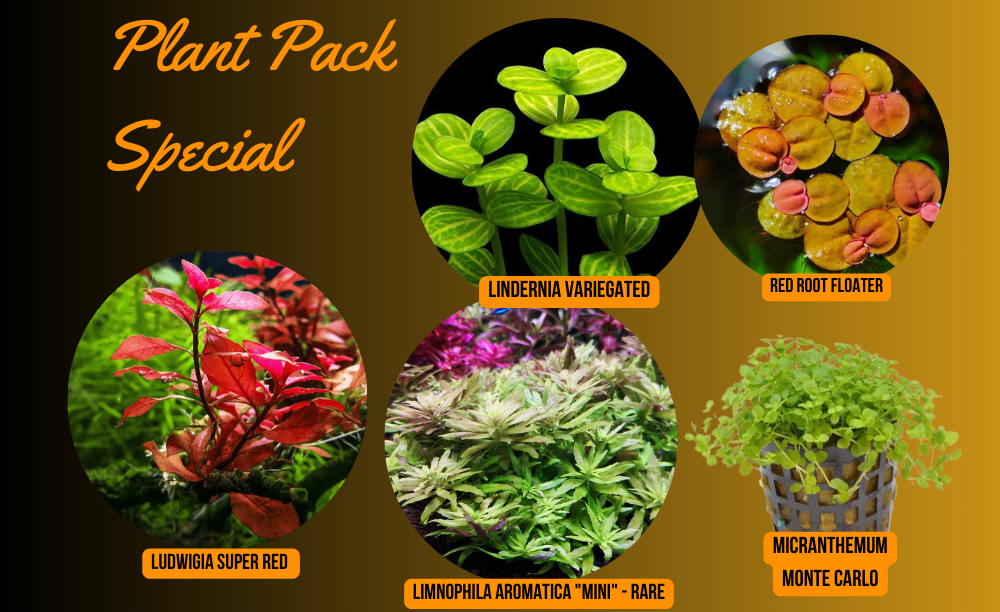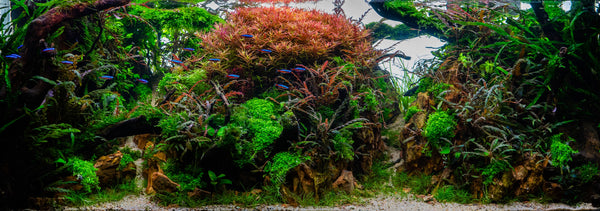Your Cart is Empty
Growing Low-Tech Carpet Plants
A carpet of delicate green plants covering your substrate always looks fantastic. In high-tech aquariums, they’re generally easy to achieve, with intense lighting and CO2 allowing for rapid growth and a wide selection of plant species.
In low-tech, it’s a little more difficult, but not impossible! With the correct plant choices and a suitable low-tech setup, you too can have a carpet in your planted tank.
Limitations of Low-Tech
In a typical low-tech aquarium, lighting is generally low to medium intensity. That’s because the plants in low-tech systems are not metabolising as fast as those with high amounts of CO2 available, so don’t require as much light or nutrients. Algae can also be an issue in low-tech with intense lighting if there is not enough plant mass and the tank is not stable.
The problem here is that carpeting plants typically enjoy more intense lighting, as they are smaller-leaved and deep in the tank where light is less able to penetrate.
The lack of CO2 is also an issue for some carpeting plants and will increase the amount of time it takes to achieve a “full” carpet effect.
Finally, if you are using tissue culture or otherwise emersed form plants, they will need time to transition to their submerged form. This is a fast process in high-tech setups thanks to the abundance of CO2 and allows plants to transition or adapt with minimal stress.
However, it can take some time in a low-tech aquarium. A stable environment will need to be provided to minimise stress, which is also important for submerged growth plants that are acclimatising to your specific water parameters.
What are my options?
Keeping these limitations in mind, the easiest carpeting plants to grow in low-tech systems include Staurogyne repens, Micranthemum Monte Carlo, Cryptocoryne Parva, ( most crypt species are suitable for a low tech system) Marsilea drummondii.
Slightly more challenging species include the ever popular Hemianthus callitrichoides aka HC and Glossostigma elatinoides aka Glosso.
To set yourself up for success with carpeting plants in low-tech, there are a few considerations you should make.
Tank Size and Lighting
First, take your tank size and lighting into consideration. If you have a small or shallow tank, your light is going to be stronger at the substrate than in deeper tanks. Depending on the strength of your light, you may be able to grow more light-demanding carpeting plants like glossostigma.
If your tank is larger or deeper, lighting will not be as powerful at the substrate, so you will need to limit yourself to the easiest options like Pearl Weed or Cryptocoryne Parva – again, depending on the strength of your light.
Believe it or not, you can run intense lighting on a low-tech tank without a speck of algae appearing. A small planted aquarium with a bright floodlight blasting over it can thrive as long as you provide the key components – stability, a large, healthy plant mass, and cleanliness. By providing intense lighting you will greatly increase your chances of growing and keeping a healthy carpet.
Substrate
Next, it’s recommended to provide a nutrient-rich substrate by using organic potting soil or topsoil. You can literally just dig up some dirt from your garden although commercially made organic soils are likely going to be better quality.
A thin layer of soil capped by sand, fine gravel or aquasoil will provide excellent nutrition for all of your plants. As the organic content is processed by your bacteria, a byproduct of CO2 is released, albeit in small amounts.
This small amount of CO2 created by your soil substrate will give your carpeting plants (and the rest of your aquarium plants) a growth boost to allow for faster, more lush carpeting. The fine cap and soil texture also allows for the smaller root systems of carpeting plants to take hold easier than in larger grain substrates.
The important thing to remember with a DIY soil substrate like this is to cap it well, and to not disturb the soil layer after capping – you don’t want to release all of that accumulated organic waste into your water column!
Stability
Minimising the stress your new carpeting plants face as they acclimatise to your parameters or transition from emersed to submerged growth is very important. Without a stable environment, plants will be continually stressed as they attempt to adapt to ever-changing conditions and won’t be able to start growing.
To provide as stress-free an environment as possible, make sure your aquarium is fully cycled before planting your carpet. This means your tank has been established with a healthy bed of beneficial bacteria in your filter for a few weeks. Doing this ensures there won’t be dangerous levels of ammonia which can damage plants, especially delicate carpeting varieties.
Allowing your tank to mature and stabilise will also reduce the chance of algae appearing, which can be a big problem in carpeting plants – especially if you’re using intense lighting to grow more difficult species.
If you’re buying carpeting plants that have been grown submerged, getting them from your local store is a great option as they have had time to adapt to water parameters of the area. It’s likely the water in your own aquarium is similar, so the stress of transitioning from one tank to another will be reduced.
Liverpool Creek Aquariums provides quality carpeting plants to stores around Australia – check your local store to see if they stock LCA plants!
Planting
Planting technique is of the utmost importance with carpeting plants. If you plant in large clumps, many leaves will not receive enough light, flow of water and nutrients through the plant will be impeded, they will not grow roots easily and may become stunted from overcrowding.
The secret to planting carpets is to use small clumps spread out to cover your substrate in a grid-like formation, with a gap of a few centimetres between each clump. This allows for the plant to spread out and grow roots easily, with light and nutrients reaching all parts of each clump.
Planting smaller individual clumps instead of a few big ones also allows you to fill out your carpet more quickly, as more of the substrate is covered with plants to begin with.
Choose the right carpeting species for your tank size and lighting then
follow these recommendations for the best chance of success.
You can grow a carpet in low-tech, you just need to provide the right conditions!
From the LCA Team
Every Solution For Your Aquarium
In low-tech, it’s a little more difficult, but not impossible! With the correct plant choices and a suitable low-tech setup, you too can have a carpet in your planted tank.
Limitations of Low-Tech
In a typical low-tech aquarium, lighting is generally low to medium intensity. That’s because the plants in low-tech systems are not metabolising as fast as those with high amounts of CO2 available, so don’t require as much light or nutrients. Algae can also be an issue in low-tech with intense lighting if there is not enough plant mass and the tank is not stable.
The problem here is that carpeting plants typically enjoy more intense lighting, as they are smaller-leaved and deep in the tank where light is less able to penetrate.
The lack of CO2 is also an issue for some carpeting plants and will increase the amount of time it takes to achieve a “full” carpet effect.
Finally, if you are using tissue culture or otherwise emersed form plants, they will need time to transition to their submerged form. This is a fast process in high-tech setups thanks to the abundance of CO2 and allows plants to transition or adapt with minimal stress.
However, it can take some time in a low-tech aquarium. A stable environment will need to be provided to minimise stress, which is also important for submerged growth plants that are acclimatising to your specific water parameters.
What are my options?
Keeping these limitations in mind, the easiest carpeting plants to grow in low-tech systems include Staurogyne repens, Micranthemum Monte Carlo, Cryptocoryne Parva, ( most crypt species are suitable for a low tech system) Marsilea drummondii.
Slightly more challenging species include the ever popular Hemianthus callitrichoides aka HC and Glossostigma elatinoides aka Glosso.
To set yourself up for success with carpeting plants in low-tech, there are a few considerations you should make.
Tank Size and Lighting
First, take your tank size and lighting into consideration. If you have a small or shallow tank, your light is going to be stronger at the substrate than in deeper tanks. Depending on the strength of your light, you may be able to grow more light-demanding carpeting plants like glossostigma.
If your tank is larger or deeper, lighting will not be as powerful at the substrate, so you will need to limit yourself to the easiest options like Pearl Weed or Cryptocoryne Parva – again, depending on the strength of your light.
Believe it or not, you can run intense lighting on a low-tech tank without a speck of algae appearing. A small planted aquarium with a bright floodlight blasting over it can thrive as long as you provide the key components – stability, a large, healthy plant mass, and cleanliness. By providing intense lighting you will greatly increase your chances of growing and keeping a healthy carpet.
Substrate
Next, it’s recommended to provide a nutrient-rich substrate by using organic potting soil or topsoil. You can literally just dig up some dirt from your garden although commercially made organic soils are likely going to be better quality.
A thin layer of soil capped by sand, fine gravel or aquasoil will provide excellent nutrition for all of your plants. As the organic content is processed by your bacteria, a byproduct of CO2 is released, albeit in small amounts.
This small amount of CO2 created by your soil substrate will give your carpeting plants (and the rest of your aquarium plants) a growth boost to allow for faster, more lush carpeting. The fine cap and soil texture also allows for the smaller root systems of carpeting plants to take hold easier than in larger grain substrates.
The important thing to remember with a DIY soil substrate like this is to cap it well, and to not disturb the soil layer after capping – you don’t want to release all of that accumulated organic waste into your water column!
Stability
Minimising the stress your new carpeting plants face as they acclimatise to your parameters or transition from emersed to submerged growth is very important. Without a stable environment, plants will be continually stressed as they attempt to adapt to ever-changing conditions and won’t be able to start growing.
To provide as stress-free an environment as possible, make sure your aquarium is fully cycled before planting your carpet. This means your tank has been established with a healthy bed of beneficial bacteria in your filter for a few weeks. Doing this ensures there won’t be dangerous levels of ammonia which can damage plants, especially delicate carpeting varieties.
Allowing your tank to mature and stabilise will also reduce the chance of algae appearing, which can be a big problem in carpeting plants – especially if you’re using intense lighting to grow more difficult species.
If you’re buying carpeting plants that have been grown submerged, getting them from your local store is a great option as they have had time to adapt to water parameters of the area. It’s likely the water in your own aquarium is similar, so the stress of transitioning from one tank to another will be reduced.
Liverpool Creek Aquariums provides quality carpeting plants to stores around Australia – check your local store to see if they stock LCA plants!
Planting
Planting technique is of the utmost importance with carpeting plants. If you plant in large clumps, many leaves will not receive enough light, flow of water and nutrients through the plant will be impeded, they will not grow roots easily and may become stunted from overcrowding.
The secret to planting carpets is to use small clumps spread out to cover your substrate in a grid-like formation, with a gap of a few centimetres between each clump. This allows for the plant to spread out and grow roots easily, with light and nutrients reaching all parts of each clump.
Planting smaller individual clumps instead of a few big ones also allows you to fill out your carpet more quickly, as more of the substrate is covered with plants to begin with.
Choose the right carpeting species for your tank size and lighting then
follow these recommendations for the best chance of success.
You can grow a carpet in low-tech, you just need to provide the right conditions!
From the LCA Team
Every Solution For Your Aquarium
| CHECK OUT OUR GALLERY FOR MORE INSPIRATION |









